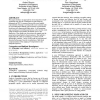Free Online Productivity Tools
i2Speak
i2Symbol
i2OCR
iTex2Img
iWeb2Print
iWeb2Shot
i2Type
iPdf2Split
iPdf2Merge
i2Bopomofo
i2Arabic
i2Style
i2Image
i2PDF
iLatex2Rtf
Sci2ools
133
click to vote
GIS
2003
ACM
2003
ACM
Attribute space visualization of demographic change
This paper introduces an approach for closer integration of selforganizing maps into the visualization of spatio-temporal phenomena in GIS. It is proposed to provide a more explicit representation of changes occurring inside socio-economic units by representing their attribute space trajectories as line features traversing a two-dimensional display space. A self-organizing map consisting of several thousand neurons is first used to create a high-resolution representation of attribute space in two dimensions. Then, multi-year observations are mapped onto the neural network and linked to form trajectories. This method is implemented for a data set containing 254 counties and 34 demographic variables. Various visual results are presented and discussed in the paper, from the visualizations of individual component planes to the mapping of voting behavior onto temporal trajectories. Categories and Subject Descriptors G.3 [Probability and Statistics]: multivariate statistics, time series ana...
Attribute Space Trajectories | Database | GIS 2003 | Temporal Trajectories | Two-dimensional Display Space |
| Added | 11 Nov 2009 |
| Updated | 11 Nov 2009 |
| Type | Conference |
| Year | 2003 |
| Where | GIS |
| Authors | André Skupin, Ron Hagelman |
Comments (0)

